Strategic Analysis of Marks and Spencer (M&S) - Strategy Report
VerifiedAdded on 2020/11/12
|22
|5754
|314
Report
AI Summary
This report provides a comprehensive strategic analysis of Marks and Spencer (M&S). It begins with an introduction to strategy and a brief overview of M&S, followed by an environmental analysis using PESTLE and Porter's Five Forces. The report then delves into SWOT and VRIO analyses to assess M&S's internal and external environments, identifying strengths, weaknesses, opportunities, and threats. The study also examines corporate social responsibility, various strategic models like the Ansoff matrix and Porter's generic strategies, and the Bowman strategy clock. The report concludes with strategic recommendations for M&S's future development and growth, offering insights into how the company can sustain its competitive advantage in the retail market. The analysis covers financial positions, market size, and the company's strategic development process.
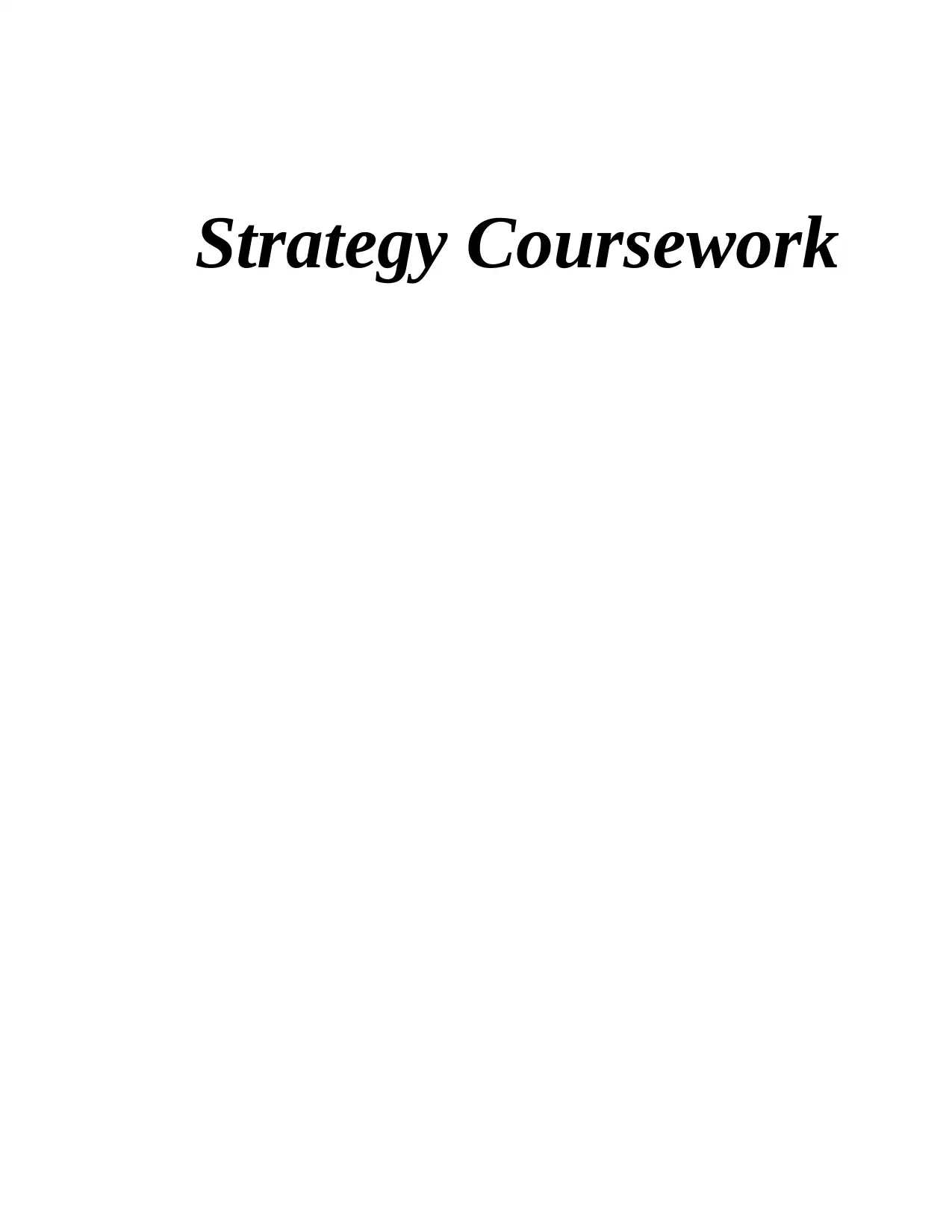
Strategy Coursework
Paraphrase This Document
Need a fresh take? Get an instant paraphrase of this document with our AI Paraphraser
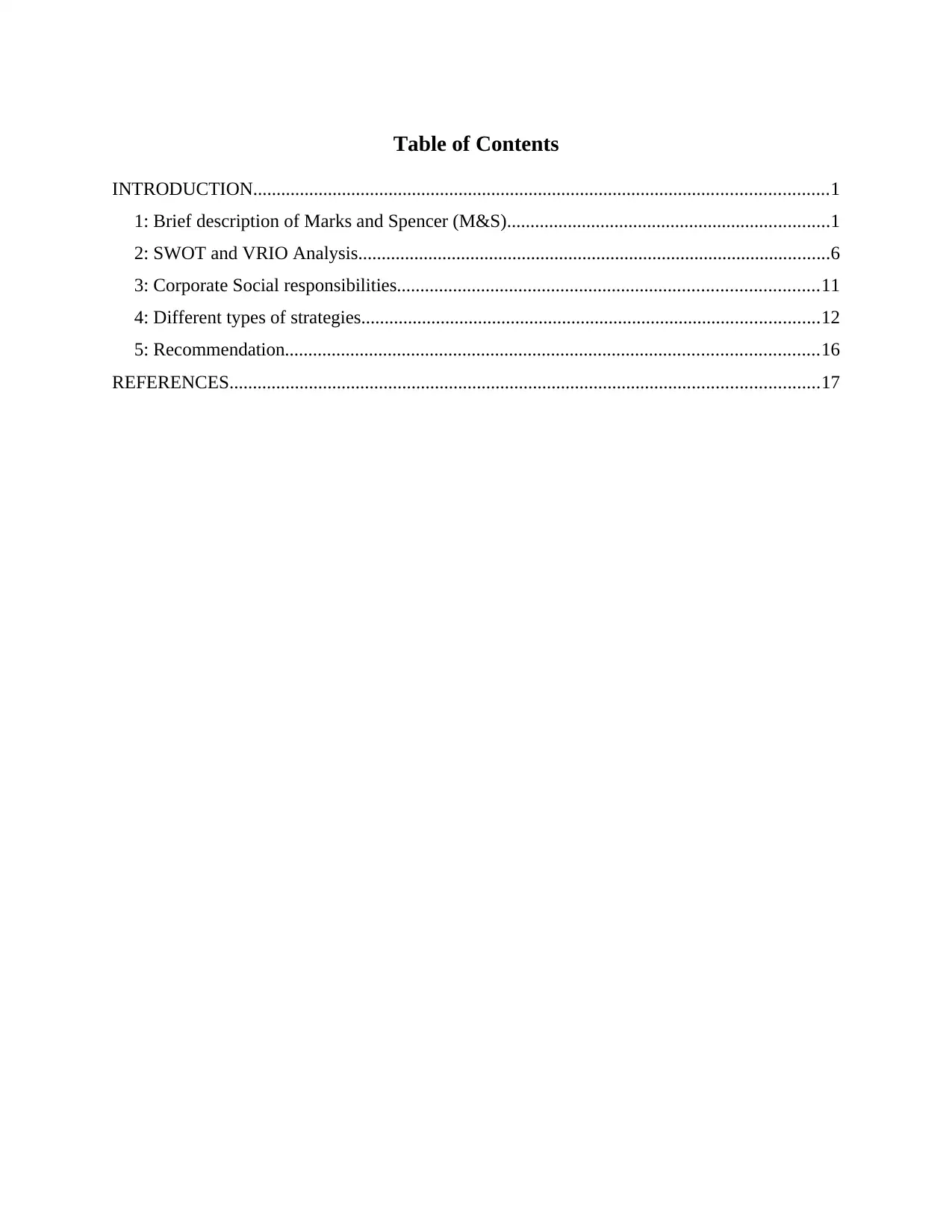
Table of Contents
INTRODUCTION...........................................................................................................................1
1: Brief description of Marks and Spencer (M&S).....................................................................1
2: SWOT and VRIO Analysis.....................................................................................................6
3: Corporate Social responsibilities..........................................................................................11
4: Different types of strategies..................................................................................................12
5: Recommendation..................................................................................................................16
REFERENCES..............................................................................................................................17
INTRODUCTION...........................................................................................................................1
1: Brief description of Marks and Spencer (M&S).....................................................................1
2: SWOT and VRIO Analysis.....................................................................................................6
3: Corporate Social responsibilities..........................................................................................11
4: Different types of strategies..................................................................................................12
5: Recommendation..................................................................................................................16
REFERENCES..............................................................................................................................17
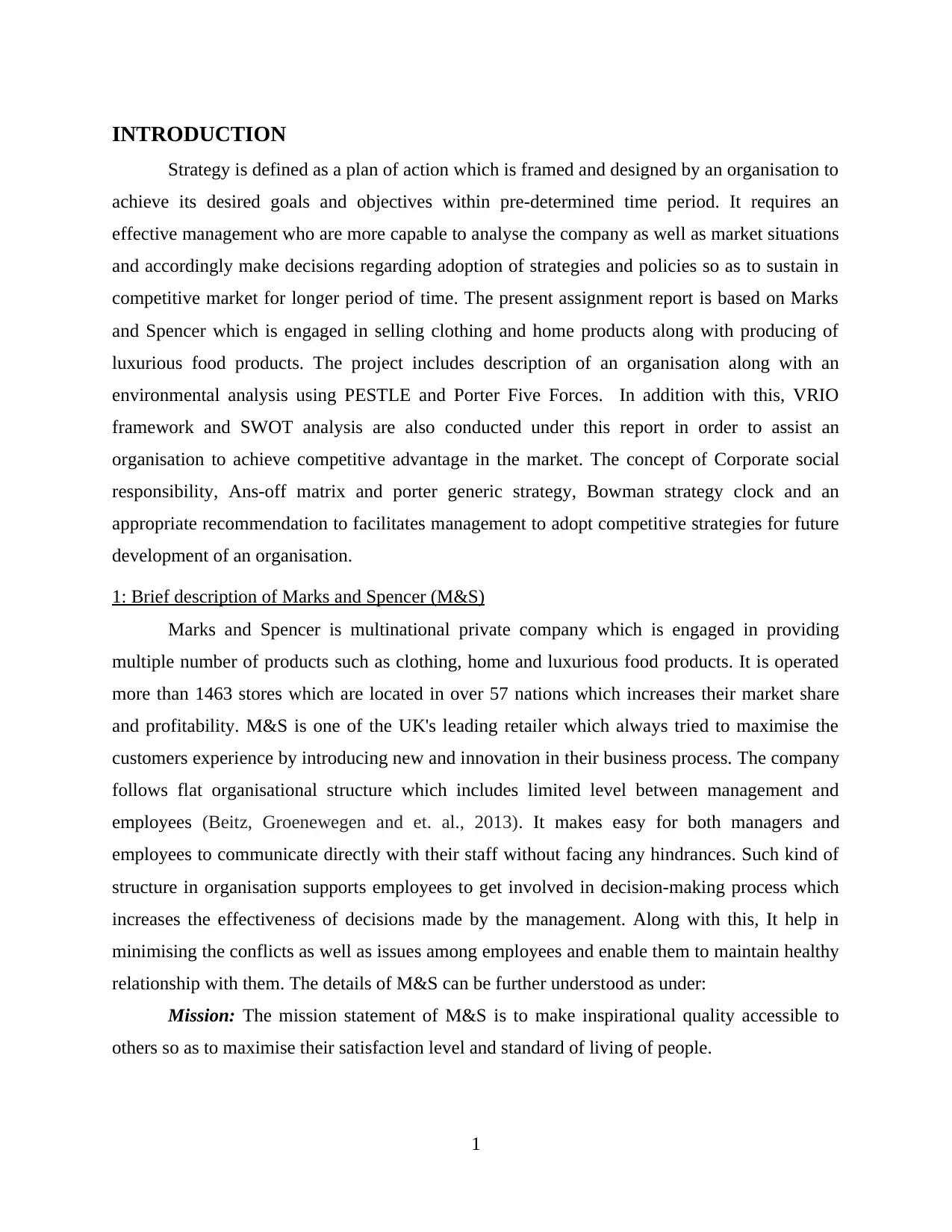
INTRODUCTION
Strategy is defined as a plan of action which is framed and designed by an organisation to
achieve its desired goals and objectives within pre-determined time period. It requires an
effective management who are more capable to analyse the company as well as market situations
and accordingly make decisions regarding adoption of strategies and policies so as to sustain in
competitive market for longer period of time. The present assignment report is based on Marks
and Spencer which is engaged in selling clothing and home products along with producing of
luxurious food products. The project includes description of an organisation along with an
environmental analysis using PESTLE and Porter Five Forces. In addition with this, VRIO
framework and SWOT analysis are also conducted under this report in order to assist an
organisation to achieve competitive advantage in the market. The concept of Corporate social
responsibility, Ans-off matrix and porter generic strategy, Bowman strategy clock and an
appropriate recommendation to facilitates management to adopt competitive strategies for future
development of an organisation.
1: Brief description of Marks and Spencer (M&S)
Marks and Spencer is multinational private company which is engaged in providing
multiple number of products such as clothing, home and luxurious food products. It is operated
more than 1463 stores which are located in over 57 nations which increases their market share
and profitability. M&S is one of the UK's leading retailer which always tried to maximise the
customers experience by introducing new and innovation in their business process. The company
follows flat organisational structure which includes limited level between management and
employees (Beitz, Groenewegen and et. al., 2013). It makes easy for both managers and
employees to communicate directly with their staff without facing any hindrances. Such kind of
structure in organisation supports employees to get involved in decision-making process which
increases the effectiveness of decisions made by the management. Along with this, It help in
minimising the conflicts as well as issues among employees and enable them to maintain healthy
relationship with them. The details of M&S can be further understood as under:
Mission: The mission statement of M&S is to make inspirational quality accessible to
others so as to maximise their satisfaction level and standard of living of people.
1
Strategy is defined as a plan of action which is framed and designed by an organisation to
achieve its desired goals and objectives within pre-determined time period. It requires an
effective management who are more capable to analyse the company as well as market situations
and accordingly make decisions regarding adoption of strategies and policies so as to sustain in
competitive market for longer period of time. The present assignment report is based on Marks
and Spencer which is engaged in selling clothing and home products along with producing of
luxurious food products. The project includes description of an organisation along with an
environmental analysis using PESTLE and Porter Five Forces. In addition with this, VRIO
framework and SWOT analysis are also conducted under this report in order to assist an
organisation to achieve competitive advantage in the market. The concept of Corporate social
responsibility, Ans-off matrix and porter generic strategy, Bowman strategy clock and an
appropriate recommendation to facilitates management to adopt competitive strategies for future
development of an organisation.
1: Brief description of Marks and Spencer (M&S)
Marks and Spencer is multinational private company which is engaged in providing
multiple number of products such as clothing, home and luxurious food products. It is operated
more than 1463 stores which are located in over 57 nations which increases their market share
and profitability. M&S is one of the UK's leading retailer which always tried to maximise the
customers experience by introducing new and innovation in their business process. The company
follows flat organisational structure which includes limited level between management and
employees (Beitz, Groenewegen and et. al., 2013). It makes easy for both managers and
employees to communicate directly with their staff without facing any hindrances. Such kind of
structure in organisation supports employees to get involved in decision-making process which
increases the effectiveness of decisions made by the management. Along with this, It help in
minimising the conflicts as well as issues among employees and enable them to maintain healthy
relationship with them. The details of M&S can be further understood as under:
Mission: The mission statement of M&S is to make inspirational quality accessible to
others so as to maximise their satisfaction level and standard of living of people.
1
⊘ This is a preview!⊘
Do you want full access?
Subscribe today to unlock all pages.

Trusted by 1+ million students worldwide
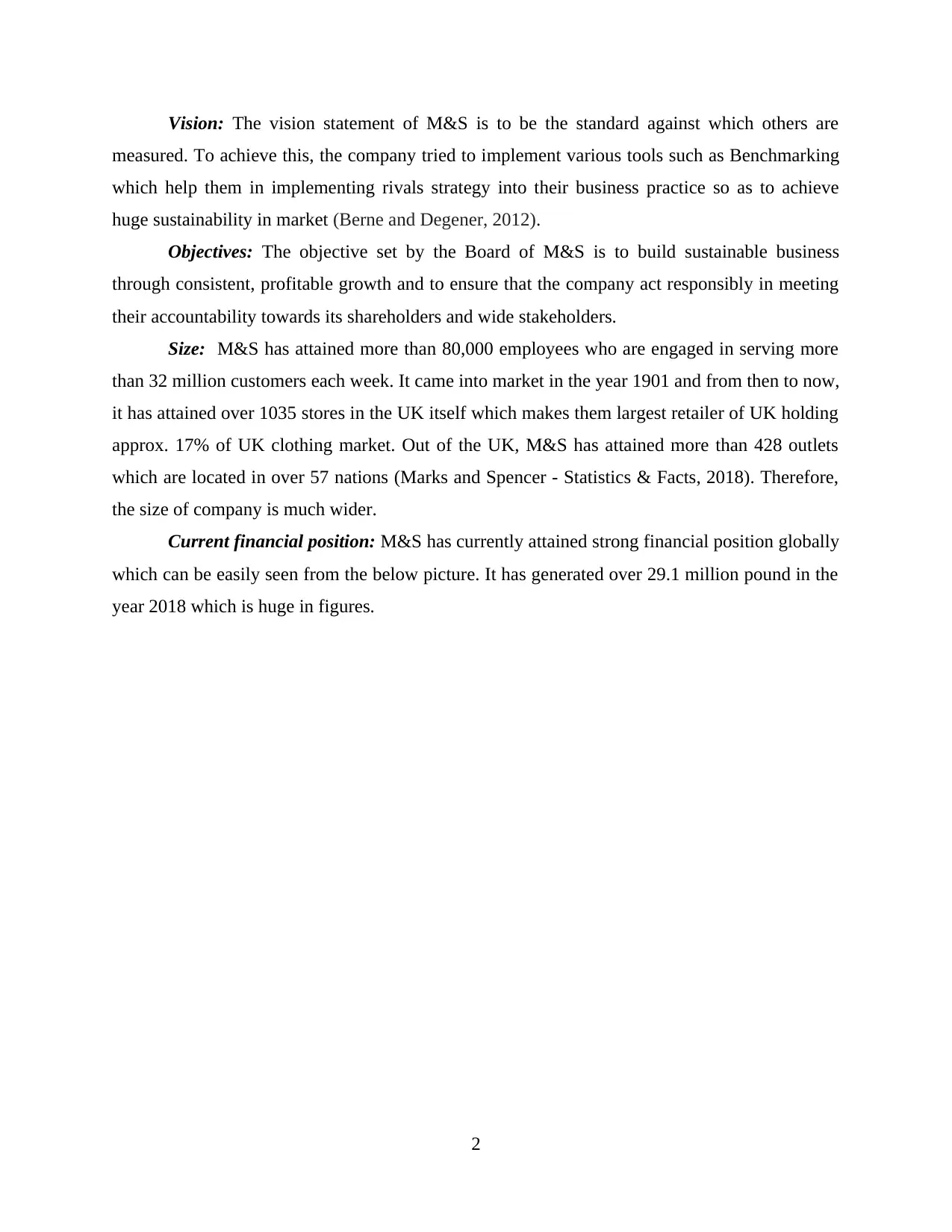
Vision: The vision statement of M&S is to be the standard against which others are
measured. To achieve this, the company tried to implement various tools such as Benchmarking
which help them in implementing rivals strategy into their business practice so as to achieve
huge sustainability in market (Berne and Degener, 2012).
Objectives: The objective set by the Board of M&S is to build sustainable business
through consistent, profitable growth and to ensure that the company act responsibly in meeting
their accountability towards its shareholders and wide stakeholders.
Size: M&S has attained more than 80,000 employees who are engaged in serving more
than 32 million customers each week. It came into market in the year 1901 and from then to now,
it has attained over 1035 stores in the UK itself which makes them largest retailer of UK holding
approx. 17% of UK clothing market. Out of the UK, M&S has attained more than 428 outlets
which are located in over 57 nations (Marks and Spencer - Statistics & Facts, 2018). Therefore,
the size of company is much wider.
Current financial position: M&S has currently attained strong financial position globally
which can be easily seen from the below picture. It has generated over 29.1 million pound in the
year 2018 which is huge in figures.
2
measured. To achieve this, the company tried to implement various tools such as Benchmarking
which help them in implementing rivals strategy into their business practice so as to achieve
huge sustainability in market (Berne and Degener, 2012).
Objectives: The objective set by the Board of M&S is to build sustainable business
through consistent, profitable growth and to ensure that the company act responsibly in meeting
their accountability towards its shareholders and wide stakeholders.
Size: M&S has attained more than 80,000 employees who are engaged in serving more
than 32 million customers each week. It came into market in the year 1901 and from then to now,
it has attained over 1035 stores in the UK itself which makes them largest retailer of UK holding
approx. 17% of UK clothing market. Out of the UK, M&S has attained more than 428 outlets
which are located in over 57 nations (Marks and Spencer - Statistics & Facts, 2018). Therefore,
the size of company is much wider.
Current financial position: M&S has currently attained strong financial position globally
which can be easily seen from the below picture. It has generated over 29.1 million pound in the
year 2018 which is huge in figures.
2
Paraphrase This Document
Need a fresh take? Get an instant paraphrase of this document with our AI Paraphraser
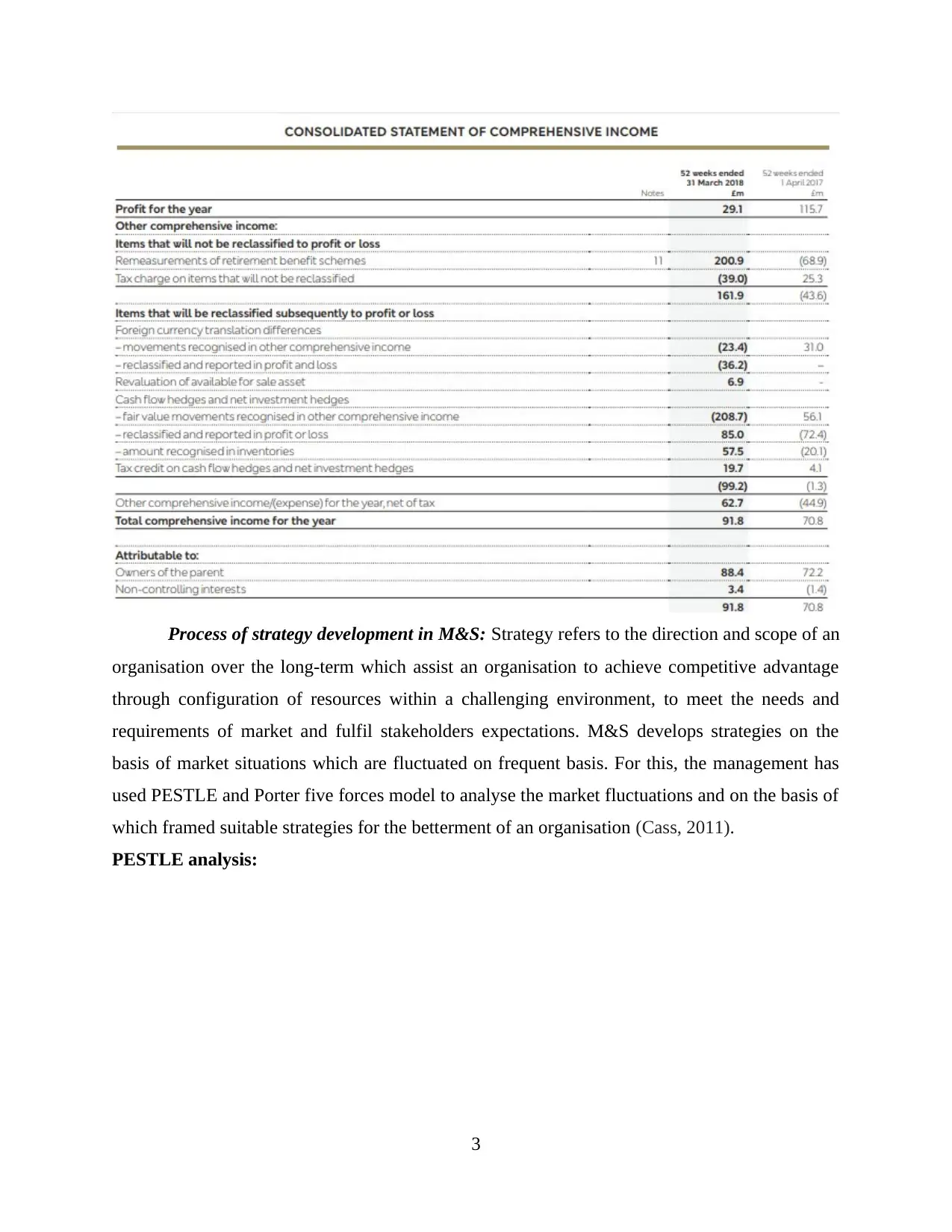
Process of strategy development in M&S: Strategy refers to the direction and scope of an
organisation over the long-term which assist an organisation to achieve competitive advantage
through configuration of resources within a challenging environment, to meet the needs and
requirements of market and fulfil stakeholders expectations. M&S develops strategies on the
basis of market situations which are fluctuated on frequent basis. For this, the management has
used PESTLE and Porter five forces model to analyse the market fluctuations and on the basis of
which framed suitable strategies for the betterment of an organisation (Cass, 2011).
PESTLE analysis:
3
organisation over the long-term which assist an organisation to achieve competitive advantage
through configuration of resources within a challenging environment, to meet the needs and
requirements of market and fulfil stakeholders expectations. M&S develops strategies on the
basis of market situations which are fluctuated on frequent basis. For this, the management has
used PESTLE and Porter five forces model to analyse the market fluctuations and on the basis of
which framed suitable strategies for the betterment of an organisation (Cass, 2011).
PESTLE analysis:
3
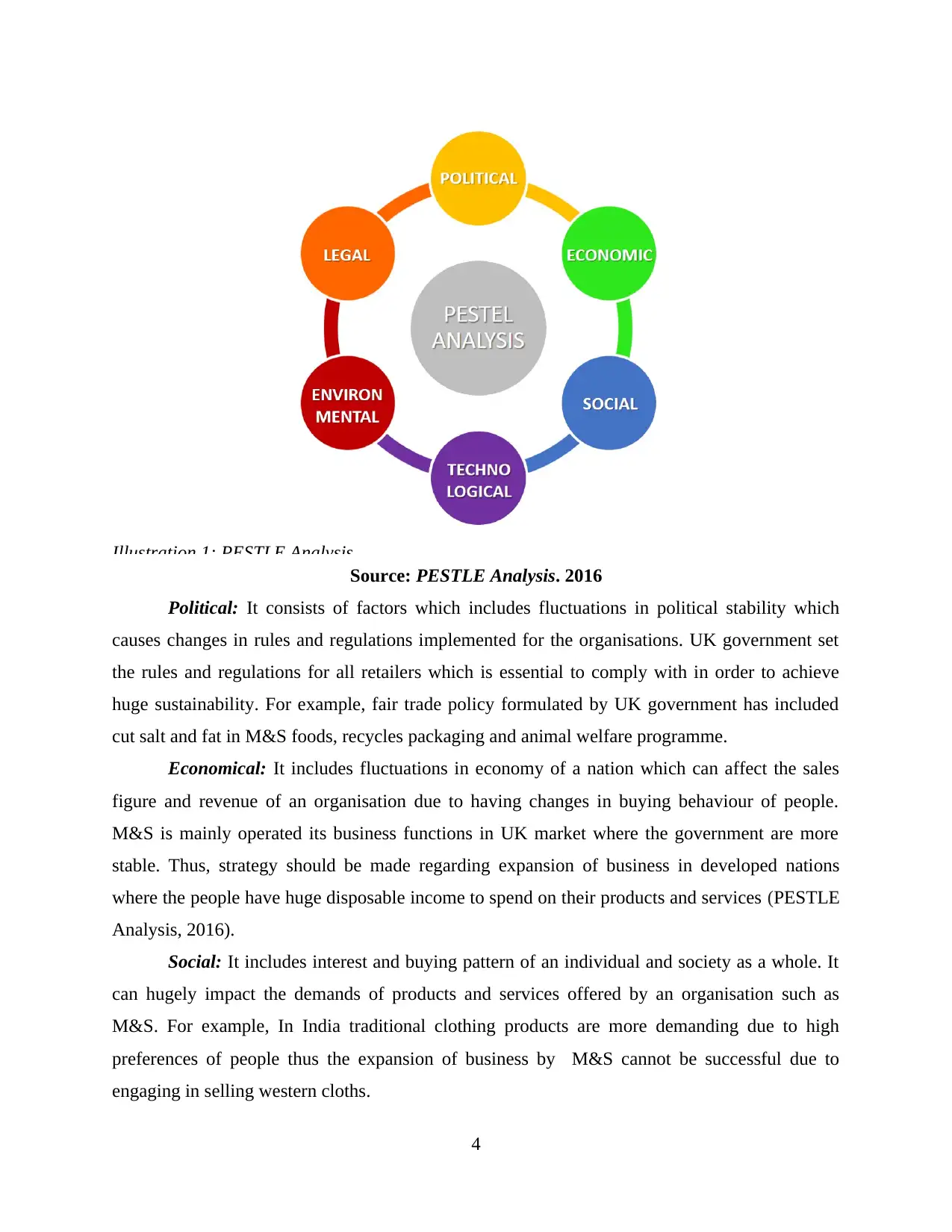
Illustration 1: PESTLE Analysis
Source: PESTLE Analysis. 2016
Political: It consists of factors which includes fluctuations in political stability which
causes changes in rules and regulations implemented for the organisations. UK government set
the rules and regulations for all retailers which is essential to comply with in order to achieve
huge sustainability. For example, fair trade policy formulated by UK government has included
cut salt and fat in M&S foods, recycles packaging and animal welfare programme.
Economical: It includes fluctuations in economy of a nation which can affect the sales
figure and revenue of an organisation due to having changes in buying behaviour of people.
M&S is mainly operated its business functions in UK market where the government are more
stable. Thus, strategy should be made regarding expansion of business in developed nations
where the people have huge disposable income to spend on their products and services (PESTLE
Analysis, 2016).
Social: It includes interest and buying pattern of an individual and society as a whole. It
can hugely impact the demands of products and services offered by an organisation such as
M&S. For example, In India traditional clothing products are more demanding due to high
preferences of people thus the expansion of business by M&S cannot be successful due to
engaging in selling western cloths.
4
Source: PESTLE Analysis. 2016
Political: It consists of factors which includes fluctuations in political stability which
causes changes in rules and regulations implemented for the organisations. UK government set
the rules and regulations for all retailers which is essential to comply with in order to achieve
huge sustainability. For example, fair trade policy formulated by UK government has included
cut salt and fat in M&S foods, recycles packaging and animal welfare programme.
Economical: It includes fluctuations in economy of a nation which can affect the sales
figure and revenue of an organisation due to having changes in buying behaviour of people.
M&S is mainly operated its business functions in UK market where the government are more
stable. Thus, strategy should be made regarding expansion of business in developed nations
where the people have huge disposable income to spend on their products and services (PESTLE
Analysis, 2016).
Social: It includes interest and buying pattern of an individual and society as a whole. It
can hugely impact the demands of products and services offered by an organisation such as
M&S. For example, In India traditional clothing products are more demanding due to high
preferences of people thus the expansion of business by M&S cannot be successful due to
engaging in selling western cloths.
4
⊘ This is a preview!⊘
Do you want full access?
Subscribe today to unlock all pages.

Trusted by 1+ million students worldwide
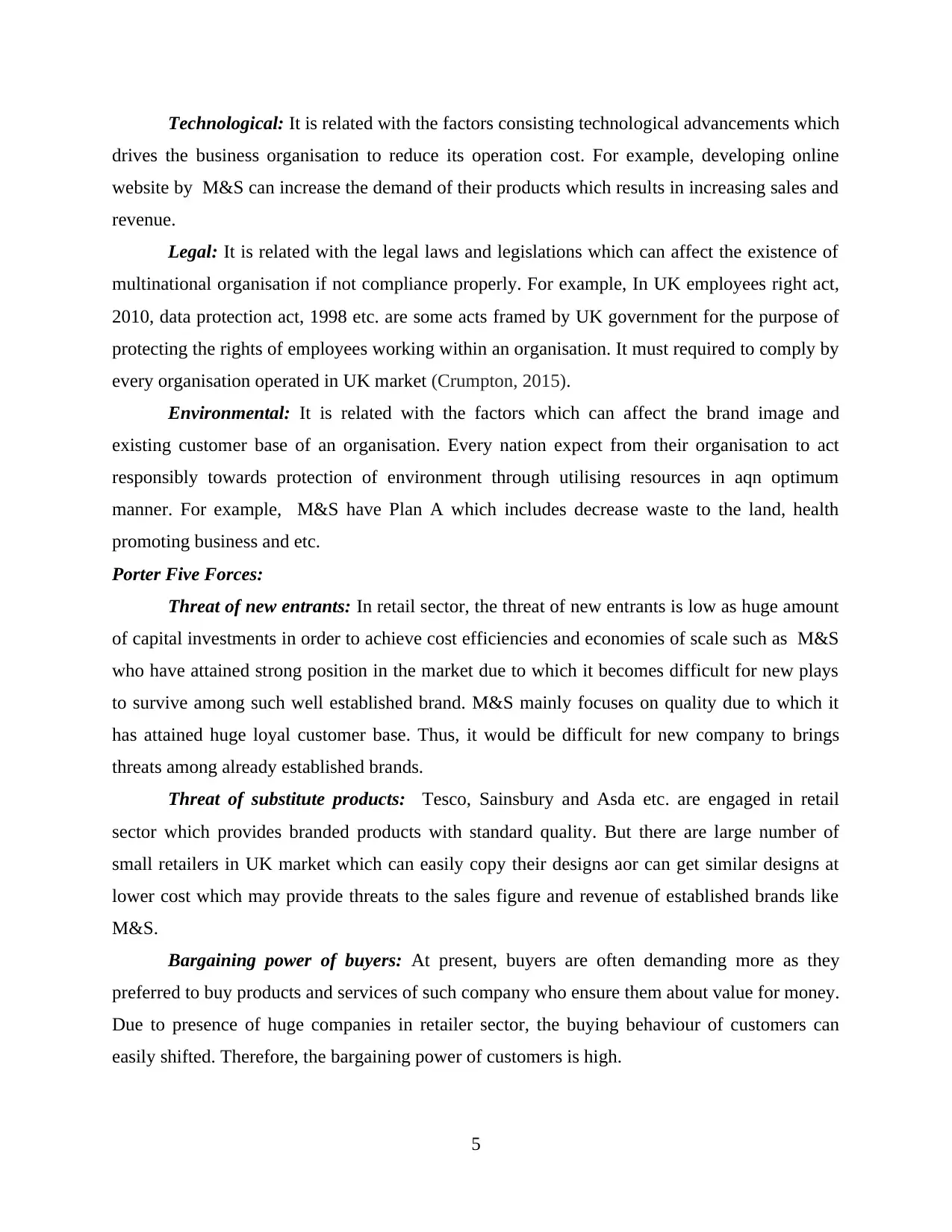
Technological: It is related with the factors consisting technological advancements which
drives the business organisation to reduce its operation cost. For example, developing online
website by M&S can increase the demand of their products which results in increasing sales and
revenue.
Legal: It is related with the legal laws and legislations which can affect the existence of
multinational organisation if not compliance properly. For example, In UK employees right act,
2010, data protection act, 1998 etc. are some acts framed by UK government for the purpose of
protecting the rights of employees working within an organisation. It must required to comply by
every organisation operated in UK market (Crumpton, 2015).
Environmental: It is related with the factors which can affect the brand image and
existing customer base of an organisation. Every nation expect from their organisation to act
responsibly towards protection of environment through utilising resources in aqn optimum
manner. For example, M&S have Plan A which includes decrease waste to the land, health
promoting business and etc.
Porter Five Forces:
Threat of new entrants: In retail sector, the threat of new entrants is low as huge amount
of capital investments in order to achieve cost efficiencies and economies of scale such as M&S
who have attained strong position in the market due to which it becomes difficult for new plays
to survive among such well established brand. M&S mainly focuses on quality due to which it
has attained huge loyal customer base. Thus, it would be difficult for new company to brings
threats among already established brands.
Threat of substitute products: Tesco, Sainsbury and Asda etc. are engaged in retail
sector which provides branded products with standard quality. But there are large number of
small retailers in UK market which can easily copy their designs aor can get similar designs at
lower cost which may provide threats to the sales figure and revenue of established brands like
M&S.
Bargaining power of buyers: At present, buyers are often demanding more as they
preferred to buy products and services of such company who ensure them about value for money.
Due to presence of huge companies in retailer sector, the buying behaviour of customers can
easily shifted. Therefore, the bargaining power of customers is high.
5
drives the business organisation to reduce its operation cost. For example, developing online
website by M&S can increase the demand of their products which results in increasing sales and
revenue.
Legal: It is related with the legal laws and legislations which can affect the existence of
multinational organisation if not compliance properly. For example, In UK employees right act,
2010, data protection act, 1998 etc. are some acts framed by UK government for the purpose of
protecting the rights of employees working within an organisation. It must required to comply by
every organisation operated in UK market (Crumpton, 2015).
Environmental: It is related with the factors which can affect the brand image and
existing customer base of an organisation. Every nation expect from their organisation to act
responsibly towards protection of environment through utilising resources in aqn optimum
manner. For example, M&S have Plan A which includes decrease waste to the land, health
promoting business and etc.
Porter Five Forces:
Threat of new entrants: In retail sector, the threat of new entrants is low as huge amount
of capital investments in order to achieve cost efficiencies and economies of scale such as M&S
who have attained strong position in the market due to which it becomes difficult for new plays
to survive among such well established brand. M&S mainly focuses on quality due to which it
has attained huge loyal customer base. Thus, it would be difficult for new company to brings
threats among already established brands.
Threat of substitute products: Tesco, Sainsbury and Asda etc. are engaged in retail
sector which provides branded products with standard quality. But there are large number of
small retailers in UK market which can easily copy their designs aor can get similar designs at
lower cost which may provide threats to the sales figure and revenue of established brands like
M&S.
Bargaining power of buyers: At present, buyers are often demanding more as they
preferred to buy products and services of such company who ensure them about value for money.
Due to presence of huge companies in retailer sector, the buying behaviour of customers can
easily shifted. Therefore, the bargaining power of customers is high.
5
Paraphrase This Document
Need a fresh take? Get an instant paraphrase of this document with our AI Paraphraser
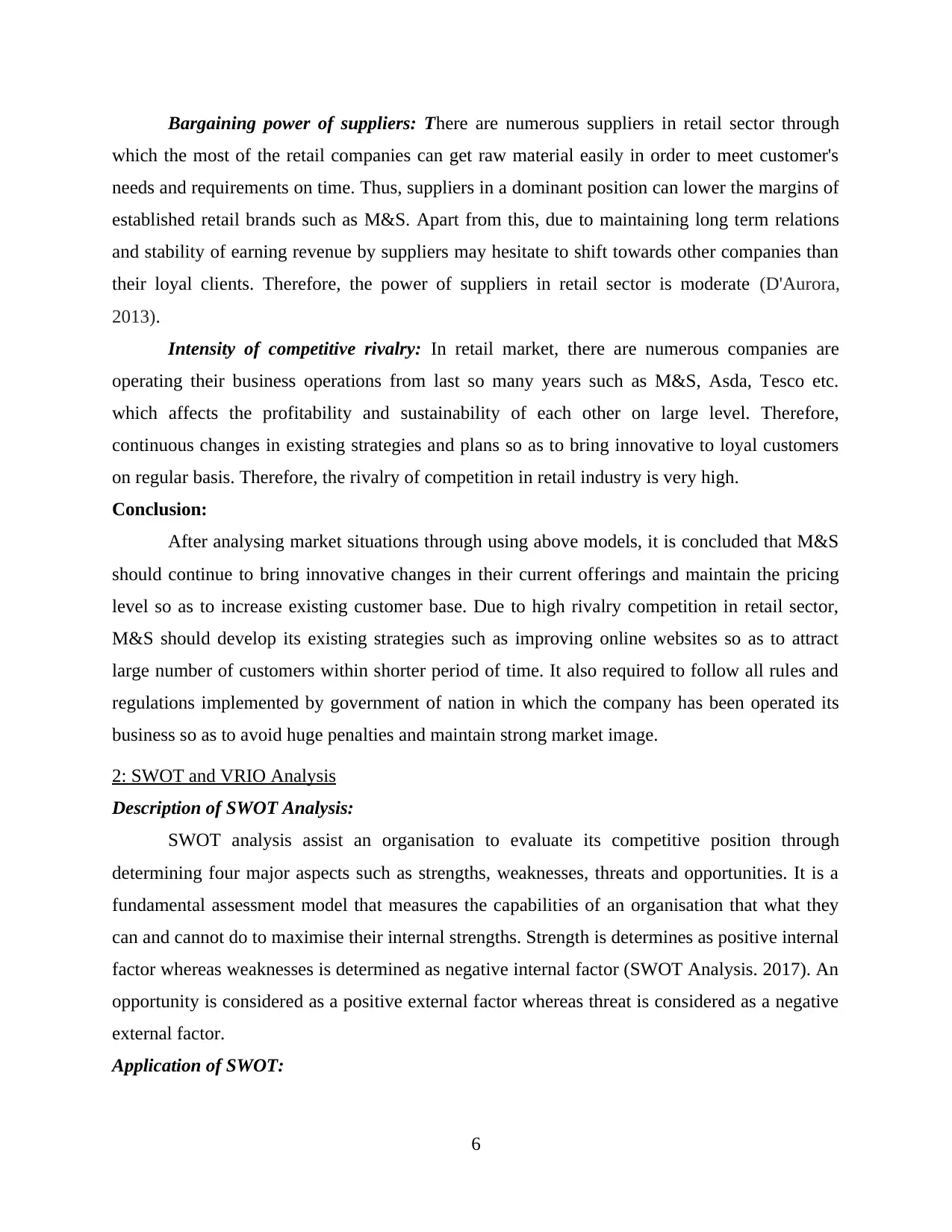
Bargaining power of suppliers: There are numerous suppliers in retail sector through
which the most of the retail companies can get raw material easily in order to meet customer's
needs and requirements on time. Thus, suppliers in a dominant position can lower the margins of
established retail brands such as M&S. Apart from this, due to maintaining long term relations
and stability of earning revenue by suppliers may hesitate to shift towards other companies than
their loyal clients. Therefore, the power of suppliers in retail sector is moderate (D'Aurora,
2013).
Intensity of competitive rivalry: In retail market, there are numerous companies are
operating their business operations from last so many years such as M&S, Asda, Tesco etc.
which affects the profitability and sustainability of each other on large level. Therefore,
continuous changes in existing strategies and plans so as to bring innovative to loyal customers
on regular basis. Therefore, the rivalry of competition in retail industry is very high.
Conclusion:
After analysing market situations through using above models, it is concluded that M&S
should continue to bring innovative changes in their current offerings and maintain the pricing
level so as to increase existing customer base. Due to high rivalry competition in retail sector,
M&S should develop its existing strategies such as improving online websites so as to attract
large number of customers within shorter period of time. It also required to follow all rules and
regulations implemented by government of nation in which the company has been operated its
business so as to avoid huge penalties and maintain strong market image.
2: SWOT and VRIO Analysis
Description of SWOT Analysis:
SWOT analysis assist an organisation to evaluate its competitive position through
determining four major aspects such as strengths, weaknesses, threats and opportunities. It is a
fundamental assessment model that measures the capabilities of an organisation that what they
can and cannot do to maximise their internal strengths. Strength is determines as positive internal
factor whereas weaknesses is determined as negative internal factor (SWOT Analysis. 2017). An
opportunity is considered as a positive external factor whereas threat is considered as a negative
external factor.
Application of SWOT:
6
which the most of the retail companies can get raw material easily in order to meet customer's
needs and requirements on time. Thus, suppliers in a dominant position can lower the margins of
established retail brands such as M&S. Apart from this, due to maintaining long term relations
and stability of earning revenue by suppliers may hesitate to shift towards other companies than
their loyal clients. Therefore, the power of suppliers in retail sector is moderate (D'Aurora,
2013).
Intensity of competitive rivalry: In retail market, there are numerous companies are
operating their business operations from last so many years such as M&S, Asda, Tesco etc.
which affects the profitability and sustainability of each other on large level. Therefore,
continuous changes in existing strategies and plans so as to bring innovative to loyal customers
on regular basis. Therefore, the rivalry of competition in retail industry is very high.
Conclusion:
After analysing market situations through using above models, it is concluded that M&S
should continue to bring innovative changes in their current offerings and maintain the pricing
level so as to increase existing customer base. Due to high rivalry competition in retail sector,
M&S should develop its existing strategies such as improving online websites so as to attract
large number of customers within shorter period of time. It also required to follow all rules and
regulations implemented by government of nation in which the company has been operated its
business so as to avoid huge penalties and maintain strong market image.
2: SWOT and VRIO Analysis
Description of SWOT Analysis:
SWOT analysis assist an organisation to evaluate its competitive position through
determining four major aspects such as strengths, weaknesses, threats and opportunities. It is a
fundamental assessment model that measures the capabilities of an organisation that what they
can and cannot do to maximise their internal strengths. Strength is determines as positive internal
factor whereas weaknesses is determined as negative internal factor (SWOT Analysis. 2017). An
opportunity is considered as a positive external factor whereas threat is considered as a negative
external factor.
Application of SWOT:
6
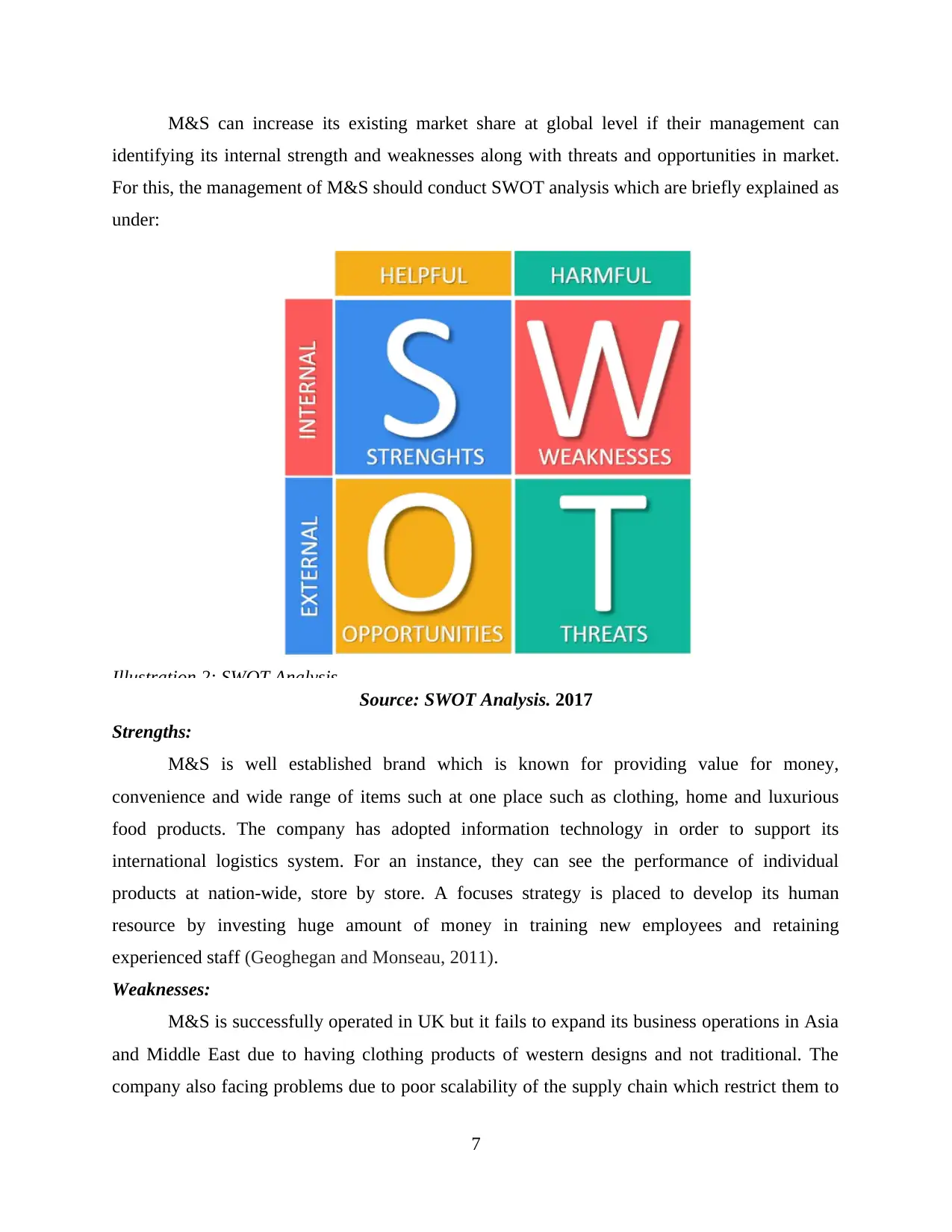
M&S can increase its existing market share at global level if their management can
identifying its internal strength and weaknesses along with threats and opportunities in market.
For this, the management of M&S should conduct SWOT analysis which are briefly explained as
under:
Illustration 2: SWOT Analysis
Source: SWOT Analysis. 2017
Strengths:
M&S is well established brand which is known for providing value for money,
convenience and wide range of items such at one place such as clothing, home and luxurious
food products. The company has adopted information technology in order to support its
international logistics system. For an instance, they can see the performance of individual
products at nation-wide, store by store. A focuses strategy is placed to develop its human
resource by investing huge amount of money in training new employees and retaining
experienced staff (Geoghegan and Monseau, 2011).
Weaknesses:
M&S is successfully operated in UK but it fails to expand its business operations in Asia
and Middle East due to having clothing products of western designs and not traditional. The
company also facing problems due to poor scalability of the supply chain which restrict them to
7
identifying its internal strength and weaknesses along with threats and opportunities in market.
For this, the management of M&S should conduct SWOT analysis which are briefly explained as
under:
Illustration 2: SWOT Analysis
Source: SWOT Analysis. 2017
Strengths:
M&S is well established brand which is known for providing value for money,
convenience and wide range of items such at one place such as clothing, home and luxurious
food products. The company has adopted information technology in order to support its
international logistics system. For an instance, they can see the performance of individual
products at nation-wide, store by store. A focuses strategy is placed to develop its human
resource by investing huge amount of money in training new employees and retaining
experienced staff (Geoghegan and Monseau, 2011).
Weaknesses:
M&S is successfully operated in UK but it fails to expand its business operations in Asia
and Middle East due to having clothing products of western designs and not traditional. The
company also facing problems due to poor scalability of the supply chain which restrict them to
7
⊘ This is a preview!⊘
Do you want full access?
Subscribe today to unlock all pages.

Trusted by 1+ million students worldwide
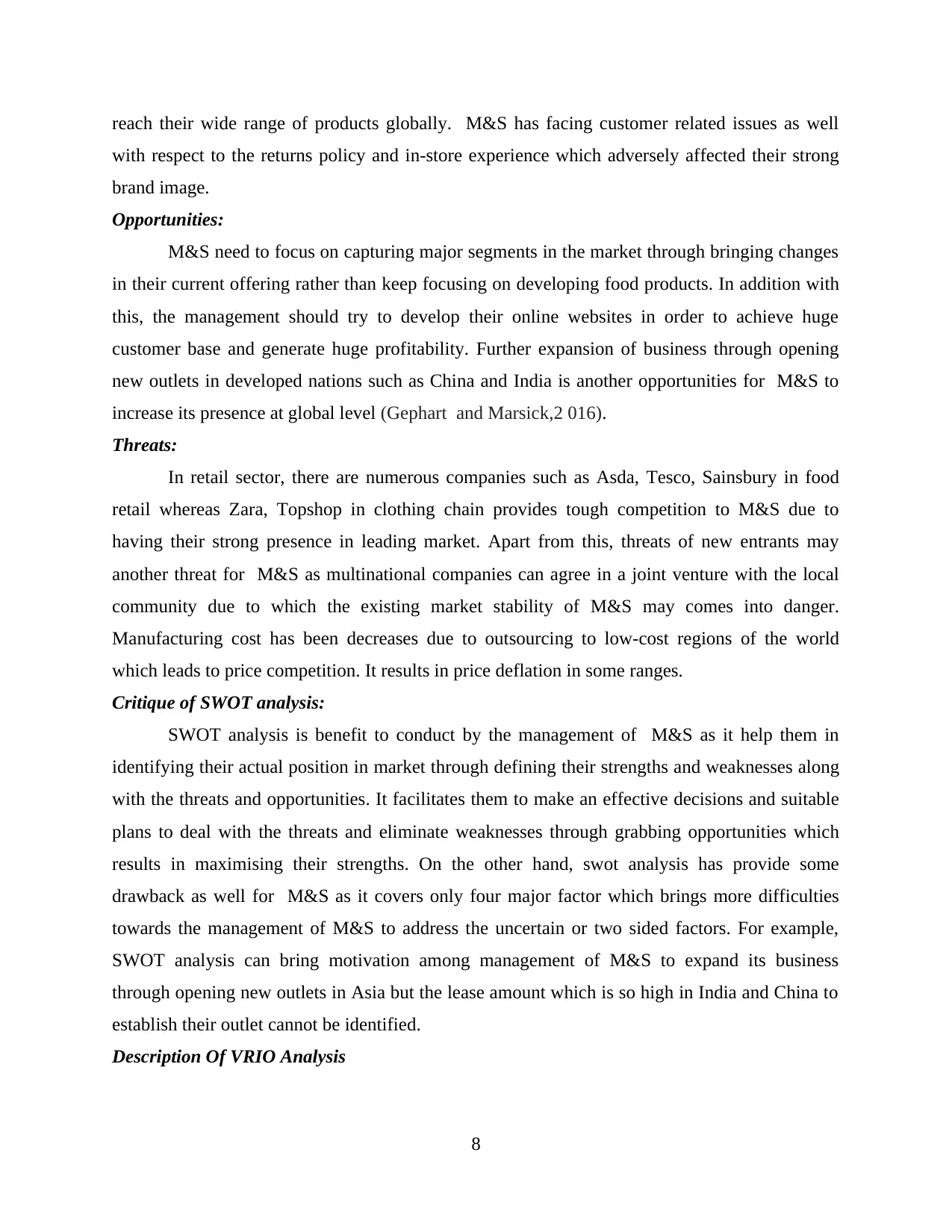
reach their wide range of products globally. M&S has facing customer related issues as well
with respect to the returns policy and in-store experience which adversely affected their strong
brand image.
Opportunities:
M&S need to focus on capturing major segments in the market through bringing changes
in their current offering rather than keep focusing on developing food products. In addition with
this, the management should try to develop their online websites in order to achieve huge
customer base and generate huge profitability. Further expansion of business through opening
new outlets in developed nations such as China and India is another opportunities for M&S to
increase its presence at global level (Gephart and Marsick,2 016).
Threats:
In retail sector, there are numerous companies such as Asda, Tesco, Sainsbury in food
retail whereas Zara, Topshop in clothing chain provides tough competition to M&S due to
having their strong presence in leading market. Apart from this, threats of new entrants may
another threat for M&S as multinational companies can agree in a joint venture with the local
community due to which the existing market stability of M&S may comes into danger.
Manufacturing cost has been decreases due to outsourcing to low-cost regions of the world
which leads to price competition. It results in price deflation in some ranges.
Critique of SWOT analysis:
SWOT analysis is benefit to conduct by the management of M&S as it help them in
identifying their actual position in market through defining their strengths and weaknesses along
with the threats and opportunities. It facilitates them to make an effective decisions and suitable
plans to deal with the threats and eliminate weaknesses through grabbing opportunities which
results in maximising their strengths. On the other hand, swot analysis has provide some
drawback as well for M&S as it covers only four major factor which brings more difficulties
towards the management of M&S to address the uncertain or two sided factors. For example,
SWOT analysis can bring motivation among management of M&S to expand its business
through opening new outlets in Asia but the lease amount which is so high in India and China to
establish their outlet cannot be identified.
Description Of VRIO Analysis
8
with respect to the returns policy and in-store experience which adversely affected their strong
brand image.
Opportunities:
M&S need to focus on capturing major segments in the market through bringing changes
in their current offering rather than keep focusing on developing food products. In addition with
this, the management should try to develop their online websites in order to achieve huge
customer base and generate huge profitability. Further expansion of business through opening
new outlets in developed nations such as China and India is another opportunities for M&S to
increase its presence at global level (Gephart and Marsick,2 016).
Threats:
In retail sector, there are numerous companies such as Asda, Tesco, Sainsbury in food
retail whereas Zara, Topshop in clothing chain provides tough competition to M&S due to
having their strong presence in leading market. Apart from this, threats of new entrants may
another threat for M&S as multinational companies can agree in a joint venture with the local
community due to which the existing market stability of M&S may comes into danger.
Manufacturing cost has been decreases due to outsourcing to low-cost regions of the world
which leads to price competition. It results in price deflation in some ranges.
Critique of SWOT analysis:
SWOT analysis is benefit to conduct by the management of M&S as it help them in
identifying their actual position in market through defining their strengths and weaknesses along
with the threats and opportunities. It facilitates them to make an effective decisions and suitable
plans to deal with the threats and eliminate weaknesses through grabbing opportunities which
results in maximising their strengths. On the other hand, swot analysis has provide some
drawback as well for M&S as it covers only four major factor which brings more difficulties
towards the management of M&S to address the uncertain or two sided factors. For example,
SWOT analysis can bring motivation among management of M&S to expand its business
through opening new outlets in Asia but the lease amount which is so high in India and China to
establish their outlet cannot be identified.
Description Of VRIO Analysis
8
Paraphrase This Document
Need a fresh take? Get an instant paraphrase of this document with our AI Paraphraser
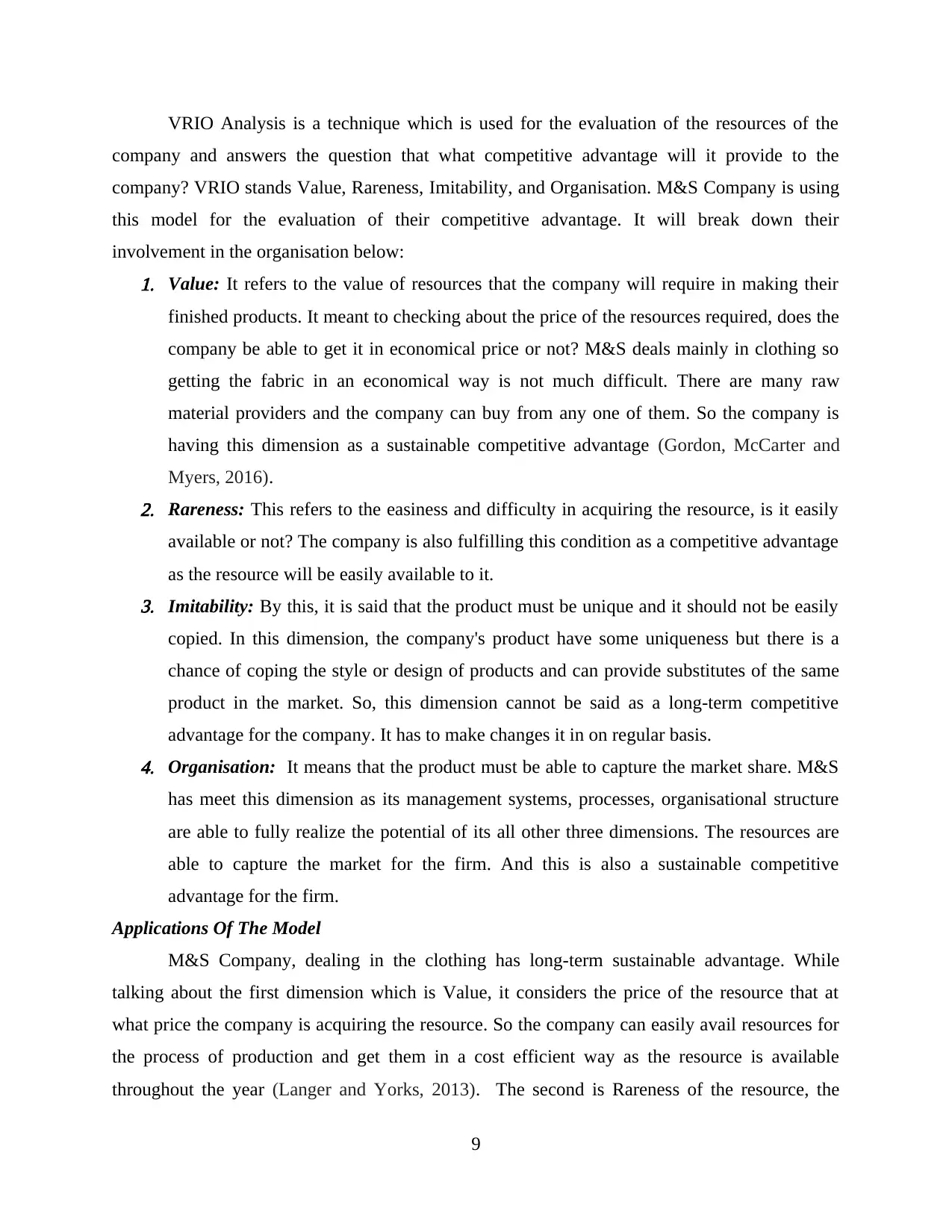
VRIO Analysis is a technique which is used for the evaluation of the resources of the
company and answers the question that what competitive advantage will it provide to the
company? VRIO stands Value, Rareness, Imitability, and Organisation. M&S Company is using
this model for the evaluation of their competitive advantage. It will break down their
involvement in the organisation below:1. Value: It refers to the value of resources that the company will require in making their
finished products. It meant to checking about the price of the resources required, does the
company be able to get it in economical price or not? M&S deals mainly in clothing so
getting the fabric in an economical way is not much difficult. There are many raw
material providers and the company can buy from any one of them. So the company is
having this dimension as a sustainable competitive advantage (Gordon, McCarter and
Myers, 2016).2. Rareness: This refers to the easiness and difficulty in acquiring the resource, is it easily
available or not? The company is also fulfilling this condition as a competitive advantage
as the resource will be easily available to it.3. Imitability: By this, it is said that the product must be unique and it should not be easily
copied. In this dimension, the company's product have some uniqueness but there is a
chance of coping the style or design of products and can provide substitutes of the same
product in the market. So, this dimension cannot be said as a long-term competitive
advantage for the company. It has to make changes it in on regular basis.4. Organisation: It means that the product must be able to capture the market share. M&S
has meet this dimension as its management systems, processes, organisational structure
are able to fully realize the potential of its all other three dimensions. The resources are
able to capture the market for the firm. And this is also a sustainable competitive
advantage for the firm.
Applications Of The Model
M&S Company, dealing in the clothing has long-term sustainable advantage. While
talking about the first dimension which is Value, it considers the price of the resource that at
what price the company is acquiring the resource. So the company can easily avail resources for
the process of production and get them in a cost efficient way as the resource is available
throughout the year (Langer and Yorks, 2013). The second is Rareness of the resource, the
9
company and answers the question that what competitive advantage will it provide to the
company? VRIO stands Value, Rareness, Imitability, and Organisation. M&S Company is using
this model for the evaluation of their competitive advantage. It will break down their
involvement in the organisation below:1. Value: It refers to the value of resources that the company will require in making their
finished products. It meant to checking about the price of the resources required, does the
company be able to get it in economical price or not? M&S deals mainly in clothing so
getting the fabric in an economical way is not much difficult. There are many raw
material providers and the company can buy from any one of them. So the company is
having this dimension as a sustainable competitive advantage (Gordon, McCarter and
Myers, 2016).2. Rareness: This refers to the easiness and difficulty in acquiring the resource, is it easily
available or not? The company is also fulfilling this condition as a competitive advantage
as the resource will be easily available to it.3. Imitability: By this, it is said that the product must be unique and it should not be easily
copied. In this dimension, the company's product have some uniqueness but there is a
chance of coping the style or design of products and can provide substitutes of the same
product in the market. So, this dimension cannot be said as a long-term competitive
advantage for the company. It has to make changes it in on regular basis.4. Organisation: It means that the product must be able to capture the market share. M&S
has meet this dimension as its management systems, processes, organisational structure
are able to fully realize the potential of its all other three dimensions. The resources are
able to capture the market for the firm. And this is also a sustainable competitive
advantage for the firm.
Applications Of The Model
M&S Company, dealing in the clothing has long-term sustainable advantage. While
talking about the first dimension which is Value, it considers the price of the resource that at
what price the company is acquiring the resource. So the company can easily avail resources for
the process of production and get them in a cost efficient way as the resource is available
throughout the year (Langer and Yorks, 2013). The second is Rareness of the resource, the
9
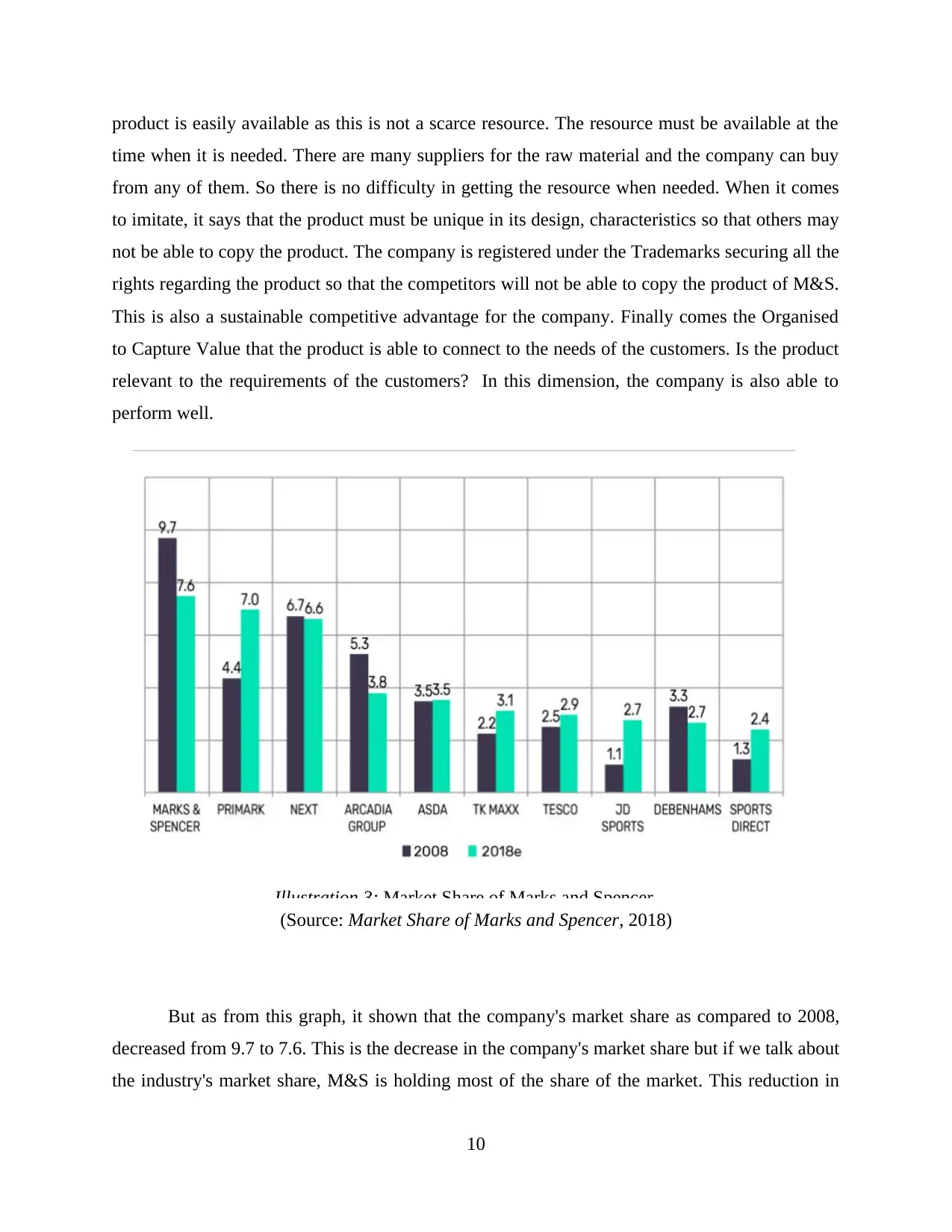
product is easily available as this is not a scarce resource. The resource must be available at the
time when it is needed. There are many suppliers for the raw material and the company can buy
from any of them. So there is no difficulty in getting the resource when needed. When it comes
to imitate, it says that the product must be unique in its design, characteristics so that others may
not be able to copy the product. The company is registered under the Trademarks securing all the
rights regarding the product so that the competitors will not be able to copy the product of M&S.
This is also a sustainable competitive advantage for the company. Finally comes the Organised
to Capture Value that the product is able to connect to the needs of the customers. Is the product
relevant to the requirements of the customers? In this dimension, the company is also able to
perform well.
(Source: Market Share of Marks and Spencer, 2018)
But as from this graph, it shown that the company's market share as compared to 2008,
decreased from 9.7 to 7.6. This is the decrease in the company's market share but if we talk about
the industry's market share, M&S is holding most of the share of the market. This reduction in
10
Illustration 3: Market Share of Marks and Spencer
time when it is needed. There are many suppliers for the raw material and the company can buy
from any of them. So there is no difficulty in getting the resource when needed. When it comes
to imitate, it says that the product must be unique in its design, characteristics so that others may
not be able to copy the product. The company is registered under the Trademarks securing all the
rights regarding the product so that the competitors will not be able to copy the product of M&S.
This is also a sustainable competitive advantage for the company. Finally comes the Organised
to Capture Value that the product is able to connect to the needs of the customers. Is the product
relevant to the requirements of the customers? In this dimension, the company is also able to
perform well.
(Source: Market Share of Marks and Spencer, 2018)
But as from this graph, it shown that the company's market share as compared to 2008,
decreased from 9.7 to 7.6. This is the decrease in the company's market share but if we talk about
the industry's market share, M&S is holding most of the share of the market. This reduction in
10
Illustration 3: Market Share of Marks and Spencer
⊘ This is a preview!⊘
Do you want full access?
Subscribe today to unlock all pages.

Trusted by 1+ million students worldwide
1 out of 22
Related Documents
Your All-in-One AI-Powered Toolkit for Academic Success.
+13062052269
info@desklib.com
Available 24*7 on WhatsApp / Email
![[object Object]](/_next/static/media/star-bottom.7253800d.svg)
Unlock your academic potential
Copyright © 2020–2025 A2Z Services. All Rights Reserved. Developed and managed by ZUCOL.




